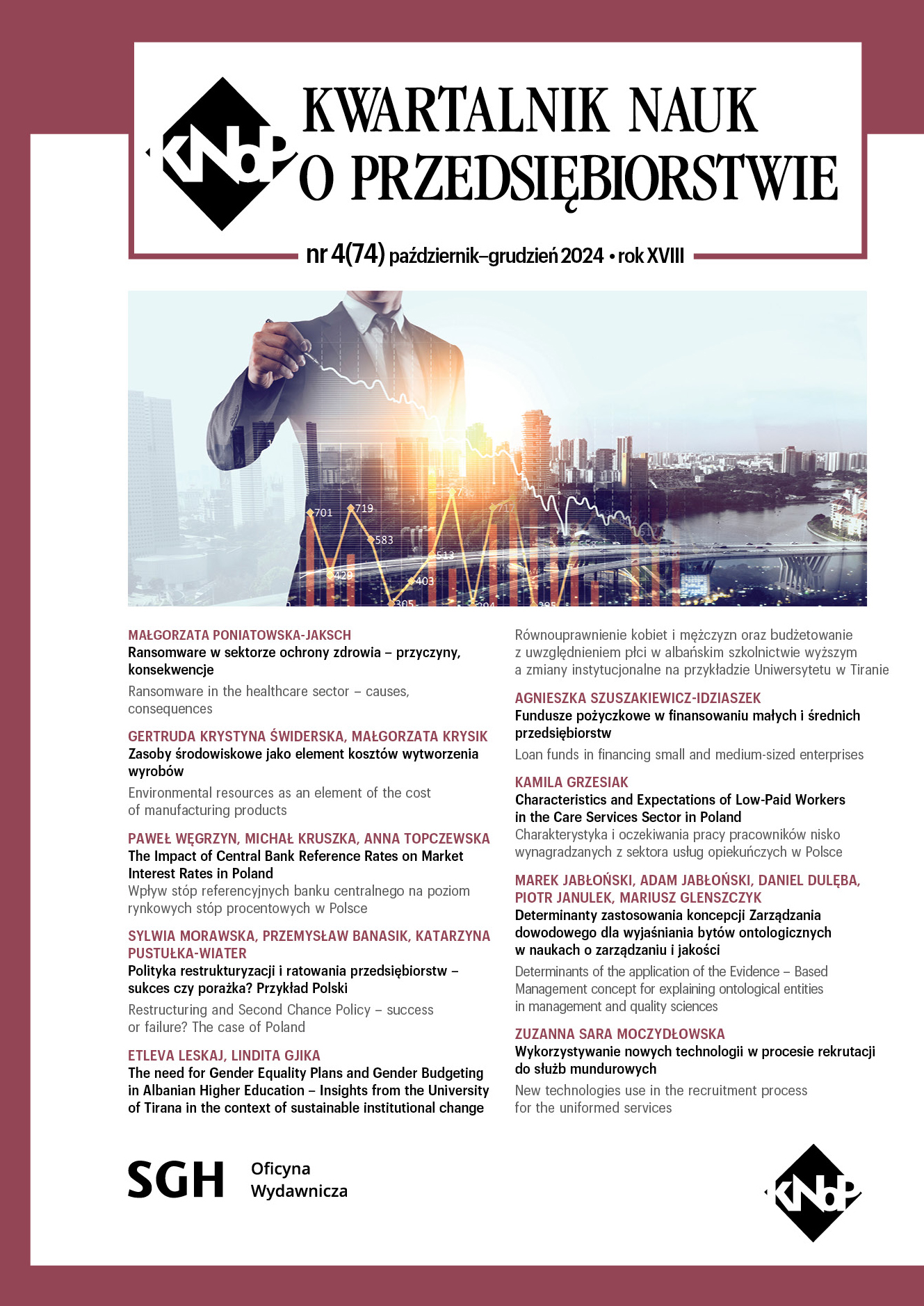Równouprawnienie kobiet i mężczyzn oraz budżetowanie z uwzględnieniem płci w albańskim szkolnictwie wyższym a zmiany instytucjonalne na przykładzie Uniwersytetu w Tiranie
Abstrakt
Promowanie równości płci oraz wzmacnianie pozycji kobiet i dziewcząt to kluczowe cele zrównoważonego rozwoju, wymagające skoordynowanych wysiłków ze strony narodów i instytucji na całym świecie, w tym sektora szkolnictwa wyższego. Niekorzystna sytuacja, jaką napotykają kobiety w albańskim systemie szkolnictwa wyższego, wskazuje na kluczowe działania na rzecz równości płci jako strategicznych instrumentów wspierania trwałych zmian instytucjonalnych. Przedstawione w artykule badania miały na celu dokonanie identyfikacji różnych aspektów nierówności płci w sektorze szkolnictwa wyższego w Albanii. Przeprowadzone badania oparto na analizie danych statystycznych, studiach przypadków oraz badań ankietowych.
Full Text
Bibliografia
Acker S., Armenti C. [2007], Sleepless in Academia, “Gender and Education”, vol. 16 (1), pp. 3–24, DOI: 10.1080/0954025032000170309.
Addabbo T., Badalassi G. [2021], Well-being gender budgeting in academia, Paper presented at STS Graz Conference on 3 rd-5th May, https://letsgeps.eu/2021/11/letsgeps-papers-on-stagewell- being-gender-budgeting-in-academia-proceedings-from-the-sts-conference-graz-2021/ (accessed: 5.09.2024).
Addabbo T., Naciti V., Noto G., Vermiglio C. [2020], Budgeting for gender equality in Research Performing Organizations, “Politica Economica”, vol. 3, pp. 417–437, DOI: 10.1429/100371.
Alshdiefat A. S., Lee A., Sharif A. A., Rana M. Q., Abu Ghunmi N. A. [2024], Women in leadership of higher education: critical barriers in Jordanian universities, “Cogent Education”, vol. 11 (1), https://doi.org/10.1080/2331186X.2024.2357900.
Bombuwela P. M., De Alwis A. C. [2013], Effects of Glass Ceiling on Women Career Development in Private Sector Organizations-Case of Sri Lanka, “Journal of Competitiveness”, vol. 5 (2), pp. 3–1, DOI: 10.7441/joc.2013.02.01.
Carvalho T., Jordão C., Diogo S. M., Breda Z. [2020], Learning organizations – a case study of changes in gender equality in decision-making bodies.
CE [2005], Final report of the Group of Specialists on Gender Budgeting (EG-S-GB), EG-S-GB, Council of Europe, Brussels.
EC [2012], Communication from the Commission to the European Parliament, the Council, the European Economic and Social Committee and the Committee of the Regions. A Reinforced European research area partnership for excellence and growth, COM, European Commission, Brussels, 392 final.
CE [2005], Final report of the Group of Specialists on Gender Budgeting (EG-S-GB), EG-S-GB, 2004, RAPFIN; Equality Division, Directorate-General of Human Rights, Council of Europe, Council of Europe, Strasbourg, p. 10, http://www.mpsv.cz/files/clanky/12462/GenderBudgeting- report2005_En.pdf (accessed: 5.09.2024).
EC [2019], She figures 2018, Direct Gen for Research and Innovation Pub Office of EU, European Commission, Luxembourg.
EC [2020], Communication from the Commission to the European Parliament, the Council, the European Economic and Social Committee and the Committee of the Regions. A Union of Equality: Gender Equality Strategy 2020–2025, COM, European Commission, Brussels, 152 final.
EC [2021], Horizon Europe Guidance on Gender Equality Plan, European Commission, Luxemburg.
ECC [2012], A Reinforced European Research Area Partnership for Excellence and Growth (COM), European Commission Communication, Brussels, p. 392.
EIGE [2016], Promoting gender equality in academia and research institutions – Main findings, European Institute for Gender Equality, Lithuania.
FGCC [1995], Good for Business: Making Full Use of the Nation’s Human Capital. U. S. Department of Labor, Federal Glass Ceiling Commission, U. S. Department of labour.
Kalpazidou Schmidt E., Cacace M. [2018], Setting up a Dynamic Framework to Activate Gender Equality Structural Transformation in Research Organizations, “Science and Public Policy”, vol. 59, pp. 1–18, doi: 10.1093/scipol/scy059.
MSWY [2016], National Strategy and Action Plan on Gender Equality of Albania 2016–2020, Ministry of Social welfare and youth, Albania.
MSWY [2021], National Strategy and Action Plan on Gender Equality of Albania 2021–2030, Ministry of Social welfare and youth, Albania.
Ní Laoire C., Linehan C., Archibong U. E., Picardi I., Udén M. [2021], Context matters: Problematizing the policy-practice interface in the enactment of gender equality action plans in universities, https://doi.org/10.1111/gwao.12594.
Osagi [2001], Gender Mainstreaming. An Overview, U. N., New York.
She Figures 2018 – European Commission (europa.eu).
Staab S., Waylen G. [2020], Institutional change in constrained circumstances: gender, resistance, and critical actors in the Chilean executive, “Lat Am Poli Soc.”, vol. 62, pp. 50–74.
Stotsky J. [2016], Gender budgeting: fiscal context and current outcomes, International Monetary Fund working paper, Washington DC, WP/16/149, p. 12.
UN [2015], Sustainable development goals, United Nations, https://sdgs.un.org/goals/goal5 (accessed: 5.09.2024).
Van de Brink M., Benschop Y., Jansen W. [2010], Transparency in Academic Recruitment; a problematic tool for gender equality, “Organization Studies”, vol. 11, pp. 1459–1483, DOI:10.1177/017084061038081.
Winchester H. P. M., Browning L. [2015], Gender equality in academia: a critical reflection, “Journal of Higher Education Policy and Management”, vol. 37 (3), pp. 269–281, https://doi.org/10.1080/1360080X.2015.1034427.
Wroblewski A., Leitner A. [2022], Relevance of Monitoring for a Reflexive Gender Equality Policy, in: Wroblewski A., Palmén R. (Eds.), Overcoming the Challenge of Structural Change in Research Organizations – A Reflexive Approach to Gender Equality, Emerald Press, pp. 33–52.
Yin R. [2009], Case study research: Design and methods, 4th ed., SAGE Publications.
Autor
Prawa autorskie (c) 2025 Kwartalnik Nauk o Przedsiębiorstwie

Utwór dostępny jest na licencji Creative Commons Uznanie autorstwa 4.0 Międzynarodowe.
Autor (Autorzy) artykułu oświadcza, że przesłane opracowanie nie narusza praw autorskich osób trzecich. Wyraża zgodę na poddanie artykułu procedurze recenzji oraz dokonanie zmian redakcyjnych. Przenosi nieodpłatnie na Oficynę Wydawniczą SGH autorskie prawa majątkowe do utworu na polach eksploatacji wymienionych w art. 50 Ustawy z dnia 4 lutego 1994 r. o prawie autorskim i prawach pokrewnych – pod warunkiem, że praca została zaakceptowana do publikacji i opublikowana.
Oficyna Wydawnicza SGH posiada autorskie prawa majątkowe do wszystkich treści czasopisma. Zamieszczenie tekstu artykuły w repozytorium, na stronie domowej autora lub na innej stronie jest dozwolone o ile nie wiąże się z pozyskiwaniem korzyści majątkowych, a tekst wyposażony będzie w informacje źródłowe (w tym również tytuł, rok, numer i adres internetowy czasopisma).
Osoby zainteresowane komercyjnym wykorzystaniem zawartości czasopisma proszone są o kontakt z Redakcją.

